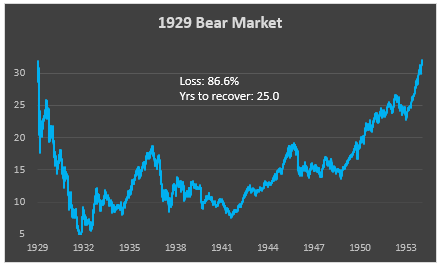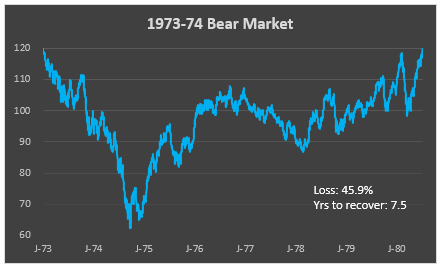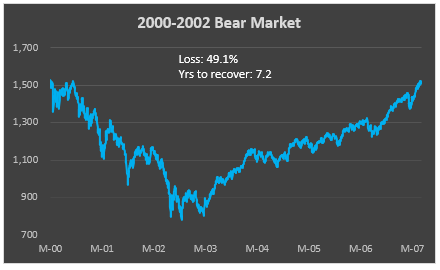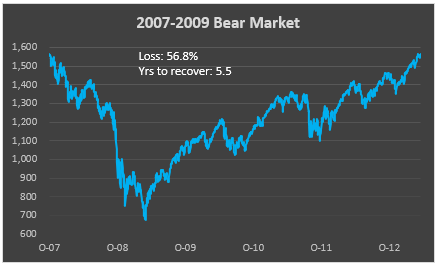Your portfolio is not going to $0.00
(That is, unless you are a gun slinging day-trader who only buys penny stocks.) For the rest of us responsible investors, I'm here to tell you that this too shall pass. It's just a matter of how long it will take, and how much time you have to ride out the storm..
Here are the facts as we know them today
- The documented cases of Coronavirus, or COVID-19, are still on the upswing. It will probably get much worse before it peaks and begins to subside. The death rate among those who get the virus is small - about 1-2%. (Somewhat higher for older patients.)
- Life as we know it is not about to end. But our normal way of living our lives has been severely restricted. This will pass.
- The stock market is going through historic convulsions, with daily swings of 5-12%. That is unprecedented. And it too will pass.
- As a result of the steps taken by government agencies to shut down any events or venues that have large crowds of people in attendance, our economy will likely enter another recession, if we haven't done so already. Recessions don't last forever.
I'm talking to investors
It may sound crass, but I'm only talking to investors in this article. I want to calm you down so that you don't panic and make mistakes that might take years to recover from. Even in normal times it's easy to let emotions drive your investment decisions. That's never a good situation.
In these extraordinary times, even skilled and experienced investors are falling into the emotion trap. I implore you not to go down that road, because you will look back at today and regret the decisions you made that were based on fear and panic.
We are now in a bear market. Have you planned for this contingency?
I've been pounding the table for years about the importance of having a Plan B for markets like this. If you have one, congratulations. Just follow your steps as written. If you don't have one, you're probably behind the curve but it's not too late.
So, your portfolio is down 20% or 30% or maybe even more? If you freeze up and do nothing, maybe things will work out eventually, but did you know that it took 25 years for the market to recover from the crash of 1929? Do you have 25 years to wait until your portfolio is made whole again?
Here's a chart of the 1929 bear market.
This was the worst bear market in the history of U.S. markets. I'm not saying that our current bear market will be as bad as the 1929 one, but it happened then, and it could happen again, especially if our policy makers get things wrong as they did in 1929.
Here's a chart of the 1973-1974 bear market.
This bear was particularly nasty for a few reasons. One, it took 7.5 years for investors to recover. Two, it was very choppy, which frustrated those who were trying to figure out when to get back in. And three, it happened during the impeachment and resignation of president Nixon, which was a rocky time for everyone.
And, it led to the hyper-inflation caused by OPEC jacking up the price of oil.
Here's a chart of the 2000-2002 bear market.
Most investors today remember the bursting of the tech bubble in 2000 and the bear market that followed. But my question is this: have they learned from it? I'm not so sure, because today (prior to the most recent crash) investors were bidding up the prices of the same kinds of tech companies that were prevalent in 2000.
Here's a chart of the 2007-2009 bear market.
Aside from the crash of 1929 and the Great Depression that followed in its wake, the bear market and global financial crisis of 2007-2009 was the worst Investors, citizens, businesses, and the government were rightfully worried that the entire financial system might collapse.
We face the same worries today. With so much uncertainty about the effects of the pandemic, and the drastic measures taken by the FED, investors and citizens are worried about a complete health and economic meltdown. It's a clear and present danger, but I believe that the odds are very low that this will come to pass.
That's why this article is meant to calm you down. If you expect the worst outcome you will be prone to making mistakes with your investment decisions. Plus, your stress level will skyrocket, which compromises your immune system, which makes you more vulnerable to contracting the virus.
So calm the f**k down, chill out, and let this scourge pass over us. The market will come back in due time, and Armageddon is still many years away.
Here's a chart of the 2020 bear market.
There's scant information available for our current bear market, but what is clear is the speed of the decline from the top on February 19th to today. I think the proliferation of ETFs has something to do with this speed, and depth of the selloff. It reminds me of what happened in 1987.
From Marketwatch - October 19, 2017
In 1987, so-called portfolio-insurance products, which were created to protect investors from falling markets, instead, helped exacerbate a breakdown on Wall Street that resulted in the largest one-day, stock-market percentage decline in history.
Portfolio insurance, employing computer algorithms, was designed to limit an investor’s loss from a plunging market, while preserving upside gains in rising markets. It consisted primarily of derivative bets, and often involved using “stock-index futures in a rising market and selling them in a falling market,” according to “A Brief History of the 1987 Stock Market Crash with a Discussion of the Federal Reserve Response” written by Mark Carlson in 2012, then an economist at the Federal Reserve. Carlson said using futures were common because it was cheaper for those firms offering such insurance products.
Read: 30 years after Black Monday, could stock market crash again?
Hayne Leland, Mark Rubinstein and John O’Brien are credited with originating the options-pricing in 1979 that would underpin what they described as portfolio-protection strategies, according to Capital Ideas: The Improbable Origins of Modern Wall Street by Peter Bernstein.
Portfolio-insurance became popular in the 1980s as institutional investors such as pension funds were increasingly concerned with elevated valuations, that often precede market corrections, defined as declines of 10% or more from a recent peak.
During the days leading up to the ‘87 crash, there were increasing worries that the collective use of these products “could snowball into a stunning rout for stocks” if investors sold stocks and futures simultaneously, Carlson wrote, citing an article written by The Wall Street Journal before the crash in 1987.
Indeed, the week before the crash of 1987, the S&P 500 index SPX, -11.98% dropped 9%, one of the largest weekly declines in decades, which triggered a sell signal for nearly all existing portfolio-insurance models.
Meanwhile, mutual funds were forced to unload shares to meet redemptions, fueling the vicious cycle of selling.
Of course, portfolio insurance wasn’t the only factor that brought the market to its knees. Some other contributors to the fall were margin calls that hamstrung liquidity and lack of reliable, real-time information.
Final thoughts
When your cherished Nest Egg is down 20% or more in just one month, it's understandable that your gut is telling you to sell before things get even worse. But is that good advice? Your intellect has a voice too, and reasonable investors will pay attention to that voice.
The market is down nearly 30% in just one month. It may go lower. In fact, I'm betting that it will go lower. But we will also have extreme up days along the way. Wouldn't it be better to hold your sales for the big up days, and buy the things you've been watching for a while on the down days?
That's what I'm advising my clients to do.






Hi Erik,
Thanks for staying in touch with us. I also wanted to let you know you have some in your audience who are (and have been for a few months) almost all cash at the moment (Plan B, phase 1), and looking for the best opportunities to re-enter the market (equities). So we’ll be eager to hear your guidance as it relates to a re-entry into equities. Thanks again.
Erik has been referring to this possibility for several months. Not that he was trying to time things but he was trying to encourage investors to have a Plan B and be wise as to when to implement it. My Plan B has saved me more than 50% of the MARKET’s downfall! Thank you, Erik!
Great article.
Thank you, Larry.
You are most welcome, George. And thank you for the kind comment.
Mark, I’m working on a new series of articles dealing with re-entry strategy. I fear we’re a long way from the bottom but you can do some nibbling on bargains right now as long as you go slowly and build your positions in stages.
FYI, The comments aren’t visible/viewable related to your 3/16/20 Post.
I am also waiting for a reentry.
Regards
Walter